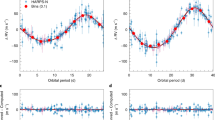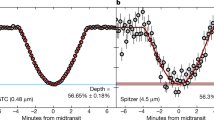Abstract
Planets orbiting other stars could in principle be found through the periodic dimming of starlight as a planet moves across—or ‘transits’—the line of sight between the observer and the star. Depending on the size of the planet relative to the star, the dimming could reach a few per cent of the apparent brightness of the star. Despite many searches, no transiting planet has been discovered in this way; the one known1,2 transiting planet—HD209458b—was first discovered using precise measurements2,3 of the parent star's radial velocity and only subsequently detected photometrically. Here we report radial velocity measurements of the star OGLE-TR-56, which was previously found to exhibit a 1.2-day transit-like light curve4,5 in a survey looking for gravitational microlensing events. The velocity changes that we detect correlate with the light curve, from which we conclude that they are probably induced by an object of around 0.9 Jupiter masses in an orbit only 0.023 au from its star. We estimate the planetary radius to be around 1.3 Jupiter radii and its density to be about 0.5 g cm-3. This object is hotter than any known planet (∼ 1,900 K), but is still stable against long-term evaporation or tidal disruption.
This is a preview of subscription content, access via your institution
Access options
Subscribe to this journal
Receive 51 print issues and online access
$199.00 per year
only $3.90 per issue
Buy this article
- Purchase on Springer Link
- Instant access to full article PDF
Prices may be subject to local taxes which are calculated during checkout


Similar content being viewed by others
References
Charbonneau, D., Brown, T. M., Latham, D. W. & Mayor, M. Detection of planetary transits across a Sun-like star. Astrophys. J. 529, L45–L48 (2000)
Henry, G. W., Marcy, G. W., Butler, R. P. & Vogt, S. S. A transiting “51 Peg-like” planet. Astrophys. J. 529, L41–L44 (2000)
Mazeh, T. et al. The spectroscopic orbit of the planetary companion transiting HD 209458. Astrophys. J. 532, L55–L58 (2000)
Udalski, A. et al. The optical gravitational lensing experiment. Search for planetary and low-luminosity object transits in the Galactic disk. Results of 2001 campaign. Acta Astron. 52, 1–37 (2002)
Udalski, A. et al. The optical gravitational lensing experiment. Search for planetary and low-luminosity object transits in the Galactic disk. Results of 2001 campaign – Supplement. Acta Astron. 52, 115–128 (2002)
Mayor, M. & Queloz, D. A Jupiter-mass companion to a solar-type star. Nature 378, 355–359 (1995)
Marcy, G. W. & Butler, R. P. Detection of extrasolar giant planets. Annu. Rev. Astron. Astrophys. 36, 57–98 (1998)
Schneider, J. The Extrasolar Planet Encyclopaedia, available at http://www.obspm.fr/encycl/encycl.html (2002).
Wolszczan, A. & Frail, D. A. A planetary system around the millisecond pulsar PSR1257 + 12. Nature 355, 145–147 (1992)
Jha, S. et al. Multicolor observations of a planetary transit of HD 209458. Astrophys. J. 540, L45–L48 (2000)
Brown, T. M., Charbonneau, D., Gilliland, R. L., Noyes, R. W. & Burrows, A. Hubble space telescope time-series photometry of the transiting planet of HD 209458. Astrophys. J. 552, 699–709 (2001)
Charbonneau, D., Brown, T. M., Noyes, R. W. & Gilliland, R. L. Detection of an extrasolar planet atmosphere. Astrophys. J. 568, 377–384 (2002)
Brown, T. M., Libbrecht, K. G. & Charbonneau, D. A search for CO absorption in the transmission spectrum of HD 209458b. Publ. Astron. Soc. Pacif. 114, 826–832 (2002)
Horne, K. in Proc. Scientific Frontiers of Research on Extrasolar Planets (eds Deming, D. & Seager, S.) (ASP, San Francisco, in the press)
Vogt, S. S., et al. in Proc. SPIE Instrum. in Astronomy VIII (eds Crawford, D. L. & Craine, E. R.) 362–375 (SPIE, Bellingham, WA, 1994)
Tinney, C. G. et al. First results from the Anglo-Australian planet search: A brown dwarf candidate and a 51 Peg-like planet. Astrophys. J. 551, 507–511 (2001)
Seager, S. & Mallén-Ornelas, G. On the unique solution of planet and star parameters from an extrasolar planet transit light curve. Astrophys. J. (submitted); preprint http://arXiv.org/astro-ph/0206228 (2002)
Zucker, S. & Mazeh, T. Study of spectroscopic binaries with TODCOR. I: A new two-dimensional correlation algorithm to derive the radial velocities of the two components. Astrophys. J. 420, 806–810 (1994)
Queloz, D. et al. No planet for HD 166435. Astron. Astrophys. 379, 279–287 (2001)
Santos, N. C. et al. The CORALIE survey for southern extra-solar planets. IX. A 1.3-day period brown dwarf disguised as a planet. Astron. Astrophys. 392, 215–229 (2002)
Trilling, D. E. et al. Orbital evolution and migration of giant planets: Modeling extrasolar planets. Astrophys. J. 500, 428–439 (1998)
Cody, A. M. & Sasselov, D. D. HD 209458: Physical parameters of the parent star and the transiting planet. Astrophys. J. 569, 451–458 (2002)
Acknowledgements
We thank A. Udalski and the OGLE team for generous contributions to this project. We are very grateful to S. Kulkarni for support, to R. Noyes and D. Latham for comments, to T. Barlow for assistance with the spectroscopic reductions using the MAKEE Keck Observatory HIRES Data Reduction Software (http://spider.ipac.caltech.edu/staff/tab/makee) and to K. Stanek for his encouragement. The data presented here were obtained at the W.M. Keck Observatory (operated by Caltech, the University of California, and NASA), which was made possible by the generous financial support of the W. M. Keck Foundation. M.K. gratefully acknowledges the support of NASA through the Michelson Fellowship programme. G.T. acknowledges support from NASA's Kepler Mission. S.J. thanks the Miller Institute for Basic Research in Science at UC Berkeley for support via a research fellowship.
Author information
Authors and Affiliations
Corresponding author
Ethics declarations
Competing interests
The authors declare that they have no competing financial interests.
Rights and permissions
About this article
Cite this article
Konacki, M., Torres, G., Jha, S. et al. An extrasolar planet that transits the disk of its parent star. Nature 421, 507–509 (2003). https://doi.org/10.1038/nature01379
Received:
Accepted:
Issue Date:
DOI: https://doi.org/10.1038/nature01379
Comments
By submitting a comment you agree to abide by our Terms and Community Guidelines. If you find something abusive or that does not comply with our terms or guidelines please flag it as inappropriate.



